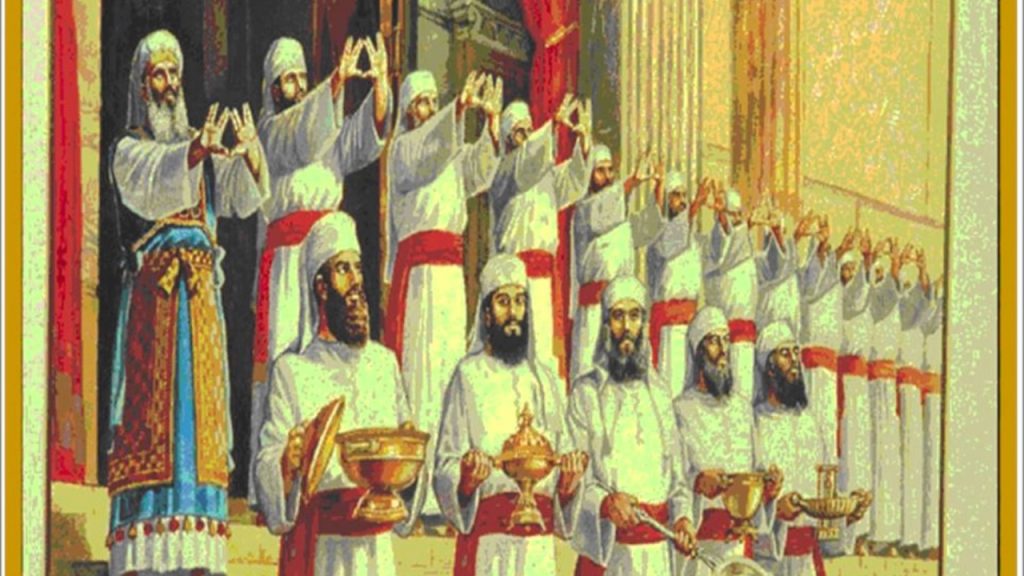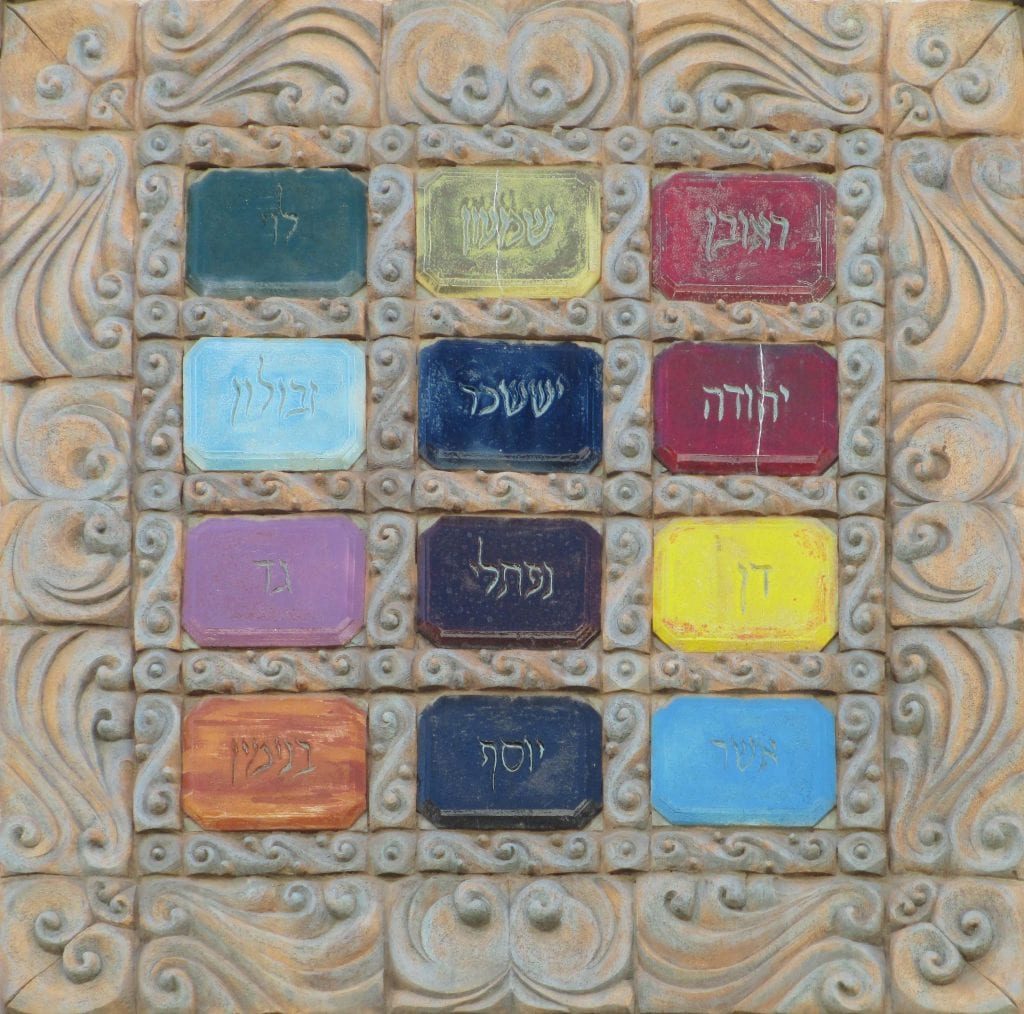Tetzaveh
Hebrew for “you command”. Parashat Tetzaveh specifically focuses on the Kohanim, the Priests who perform the rituals and sacrifices on behalf of the people. More than forty verses, are devoted to the subject of the Bigdei Kodesh, the holy clothing or ritual garments for the high priests. Does “Clothes make the man,”? It may be true, as a person’s entire character can be summed up, by a stranger, simply by how they are dressed.

In a nutshell
In the parashah G‑d tells Mosheh to receive from the children of Israel pure olive oil to feed the Ner Tamid everlasting flame of the menorah, which Ahron is to kindle each day, “from evening till morning.” G-d appoints Ahron and his sons as priests. The making of the golden altar, on which the ketoret (incense alter) was burned. Ahron is commanded to make incense offerings to G-d every morning on an altar. G-d explains that once a year Ahron will make an offering on that altar to atone for all of the Israelites’ sins.

Mosheh Rabbeinu
ADAR 7th. is the Birthdate and the Yahrtzeit of Mosheh Rabbeinu. This day occurs during the week of Parashat Tetzaveh (or shortly before it). Parashat Tetzaveh is the only parashah in the 3 books: Shemot, Vayikra, and Bamidbar in which Mosheh’s name is not mentioned. Is it a sign that his physical presence is gone? The Zohar explains, that the spirit of the tzaddik continues to exist in this world after the tzadik passes away. In the first verse of the parashah: “You shall command the children of Israel”. The word “You”, obviously refers to Mosheh, on a deeper level, it refers to his whole being, as in the entire parashah G-d speaks directly to Mosheh without mentioning his name, but his essence is present. (Based on Likutey Sichot, vol. 26)
Adar 7th.
How do we know when Mosheh Rabbeinu was born, and when he died? The Talmud proves this in the following verses: ”Today I am one hundred and twenty years old.” (Deuteronomy 31:2) וַיֹּ֣אמֶר אֲלֵהֶ֗ם בֶּן־מֵאָה֩ וְעֶשְׂרִ֨ים שָׁנָ֤ה אָֽנֹכִי֙ הַיּ֔וֹם. The Jews mourned for thirty days following Mosheh’s death in the Plains of Moab. (Deuteronomy 34:8)וַיִּבְכּוּ֩ בְנֵ֨י יִשְׂרָאֵ֧ל אֶת־משֶׁ֛ה בְּעַרְבֹ֥ת מוֹאָ֖ב שְׁלשִׁ֣ים י֑וֹם וַיִּתְּמ֔וּ יְמֵ֥י בְכִ֖י אֵ֥בֶל משֶֽׁה: The Jews crossed the river on the 10th of Nissan. If we subtract 3 days between the command and actual crossing, & the 30 days of mourning, we find the date of Mosheh’ passing is Adar 7th. (Joshua 4:19)וְהָעָ֗ם עָלוּ֙ מִן־הַיַּרְדֵּ֔ן בֶּֽעָשֹ֖וֹר לַחֹ֣דֶשׁ הָֽרִאשׁ֑וֹן וַֽיַּֽחֲנוּ֙ בַּגִּלְגָּ֔ל בִּקְצֵ֖ה מִזְרַ֥ח יְרִיחֽוֹ:
Spiritual versus physical
Judaism usually focus on the inner qualities, not outward materialism such as clothing, so what is so important about the garments of the High Priest?
The sacred garments
G-d describes the sacred garments for the priests, and explains how to properly sanctify the priests. In addition, G-d describes the sacred garments the kohen gadol-Ahron (high priest) wore, “Make Bigdei Kodesh (holy garments) for Ahron your brother,” Mosheh is told, “for dignity and splendor.”

The Ordination ceremony
The efod, an apron-like garment made of blue-, purple- and red-dyed wool, linen and gold thread; the choshen, a breastplate containing twelve precious stones inscribed with the names of the twelve tribes of Israel. Conduct an ordination ceremony, the seven day initiation of Aaron and his four sons: Nadav, Avihu, Elazar and Itamar into the priesthood, which in future generations born to these sons, as Nahmanides (Ramban-Rabbi Moses Ben Nachman) notes, there will be no consecration: birth alone will confer leadership.


Hiddur mitzvah
Hiddur Mitzvah, by adding beauty to any mitzvah (commandment), we add to the holiness of the mitzvah, through the adornment of the act, were fulfilling much more than the minimum requirement of the mitzvah. Nahmanides also notes that the commandment to dress the High Priest in garments for glory (kavod) and splendor (tiferet) is not only to enhance the status of the priest himself, but also to enhance the glory of G-d. Their elaborate attire, is actually a symbol of their service to G-d and the people.
The Talmud says that each article of the High Priest’s clothing atoned for a different Israelite sin: the coat for bloodshed; the linen trousers for sexual impropriety, etc.
Be priests for Me
In Exodus 28 and 29, the phrase to “Be priests for Me” appears four times meaning the kohanim were the servants of G-d. Rashi explains that the word “kehunah” itself means “service.” Although the kehunah is an inherited honor, it is a role defined by service. Called avodah, (work), the priestly service involved the hard physical labor necessary to prepare and offer all of the daily, Shabbat, Rosh Chodesh, and holiday sacrifices for the Israelites.

Ner Tamid
Ner Tamid, the light that hangs in front of and above the ark in the synagogue reminds us of the light of truth and the presence of G-d. The sight of a burning flame is soothing and comforting to our soul. It is like a reflection, a mirror if you will, to our own spiritual inner burning flame and desire, on one hand we strive to, invite and to connect with G-d , and at the same time, we have the will to live a physical life and make our mark upon a physical world.

The soul of man / woman is G‑d’ Ner Tamid, whose purpose in life is to illuminate the world with divine light. G‑d gave us the “oil” the Torah and its commandments (mitzvot), which embody His wisdom and convey His luminous truth. Be Ner Tamid, an eternal light to yourself and to others, spread G-d’ wisdom and truth. Let there be light. Be the light. Kol Tuv.

The 7 Mitzvot in Parashat Tetzaveh
- The Kohanim must wear their priestly garments during service Ex. 28:2
- The Kohen Gadol ‘s breastplate must not be loosened from the Efod Ex. 28:28
- Not to tear the priestly garments Ex. 28:32
- The Kohanim must eat the sacrificial meat in the Temple Ex. 29:33
- A non-Kohen must not eat sacrificial meat Ex. 29:33
- To burn incense every day Ex. 30:7
- Not to burn anything on the Golden Altar besides incense Ex. 30:9
The 613 Mitzvot
In The Torah there are 613 commandments, mitzvot, also known as the Law of Moses (תרי״ג מצוות, taryag mitzvot). The 613 mitzvot are first recorded in the 3rd century CE, when Rabbi Simlai mentioned it in a sermon that is recorded in Talmud Makkot 23b.
The 613 commandments include 248 “positive commandments”, to perform an act (mitzvot aseh), and 365 “negative commandments”, to abstain from certain acts (mitzvot lo taaseh). The negative commandments number 365, which coincides with the number of days in the solar year, and the positive commandments number 248, a number ascribed to the number of bones and main organs in the human body.
Though the number 613 is mentioned in the Talmud, its real significance increased in later medieval rabbinic literature, including many works listing or arranged by the mitzvot. The most famous of these was an enumeration of the 613 commandments by Maimonides, The Rambam.
Many of the mitzvot cannot be observed now, following the destruction of the Second Temple, although they still retain religious significance. According to one standard reckoning, there are 77 positive and 194 negative commandments that can be observed today, of which there are 26 commands that apply only within the Land of Israel. Furthermore, there are some time-related commandments from which women are exempt (examples include shofar, sukkah, lulav, tzitzit and tefillin). Some depend on the special status of a person in Judaism (such as kohanim), while others apply only to men or only to women.
Tetzaveh Mitzvot
according to Rambam Organized by Parshah. based on Wikipedia and http://www.vaadrv.org/rambam613mitzvot.aspONE BIG IMPORTANT NOTE WHEN USING THIS LISTING: This listing is not all inclusive. Rambam may site multiple sources for a mitzvah is his works but this list currently only gives one source for each mitzvah.

Check out YedidYah Psalm 96 “Yiram Hayam” Music by Rabbi Yakira Yedidia https://youtu.be/aTBD4i9nvXw
The Priestly Blessing
יְבָרֶכְךָ יהוה, וְיִשְׁמְרֶךָ- May the LORD bless you and guard you
יָאֵר יהוה פָּנָיו אֵלֶיךָ, וִיחֻנֶּךָּ -May the LORD make His face shed light upon you and be gracious unto you
יִשָּׂא יהוה פָּנָיו אֵלֶיךָ, וְיָשֵׂם לְךָ שָׁלוֹם- May the LORD lift up His face unto you and give you peace
Check out YedidYah “The Priestly Blessing” Birkat Hakohanim. Music by Rabbi Yakira Yedidia https://youtu.be/YNE11QdEMN0

#####
This blog article was inspired by chabbad.org
